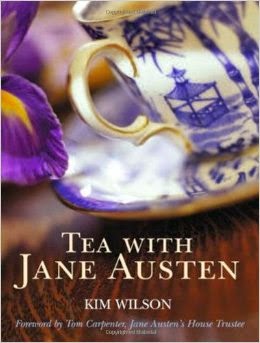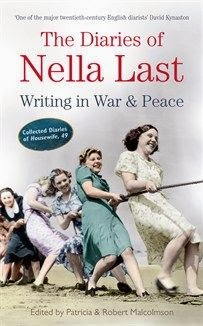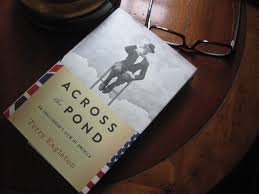I’m happy to report that the built-in bookshelves are done and painted and my library is back where it belongs. Although most books can now be found on the internet, I’m never parting with my core library, consisting primarily of books on London, Wellington, Brummell, period diaries and letters and Queen Victoria. For those of you who have expressed an interest in browsing my bookshelves, here’s a good representation of what they hold.
Category: On The Shelf
ON THE SHELF: AT HOME WITH JANE AUSTEN BY KIM WILSON
Victoria here, enjoying the wonderful pictures and copy of this new book by my friend and colleague, Kim Wilson. Don’t expect anything negative in this “review,” because I love everything Kim does unreservedly. I am sure you will agree that all her books — especially this beautiful edition from Abbeville Press — deserve all the praise I can muster.
Kim’s lively account of Jane Austen’s life is complemented with wonderful photographs and reproductions of period prints. Many of the pictures were commissioned from Gavin Kingcome, who portrays even the most familiar of views with an artist’s eye. Other photos are taken by Kim herself.
From the very beginning, you will be charmed by the pictures and prose, perfect for enjoying cover to cover or for dipping into briefly during a comforting tea break.
In the foreword by the curator of of Jane Austen’s House Museum, Chawton, Hampshire, Mary Guyatt writes, “This book cannot fail to encourage your own further exploration…” This is true for a dedicated devotee — like myself — or for a newcomer to Austen’s life and work.
Our journey with Jane Austen begins at her childhood home in Steventon, Hampshire, where she lived with her parents and sister Cassandra and her many brothers as well as some boarding students Mr. Austen taught in preparation for college. And we accompany her on the many visits she made in rural villages, sophisticated cities, and stately country mansions. Along the way, we learn about her many friends and relatives through her own words from her letters to her sister Cassandra.
On the many travels around England, we also encounter the settings for Austen’s novels, in Bath, Lyme Regis, and London. And we discover clues about the imagined settings she used, such as the estates of Pemberley and Donwell Abbey.
Gardening, fashion, balls, literature, and the theatre – all pursuits Jane Austen enjoyed – are covered, as well as the personal activities in which she excelled, e.g. playing the piano and writing.
Indulge your Janeite friends, others who need to be initiated into the delights of Austen, and above all yourself — with a gift of this gorgeous volume by Kim Wilson from Abbeville Press: At Home with Jane Austen.
On The Shelf – WWII Housewives Diaries
Lately, I’ve been engrossed in the diaries kept by British housewives during Word War II, the most well known of which is probably The Diaries of Nella Last, a Cumbrian housewife with a talent for writing who chronicled her life and times for the social research organisation Mass Observation, which set out to record everyday life in Britain through the cooperation of about five hundred volunteer observers who agreed to keep regular diary entries. Many other Mass Observation diaries, now held in the Mass Observation Archive at the University of Sussex, ended with the conclusion of World War II. Nella, however, kept sending in her diaries to the Mass Observation office in London and continued writing until 1966 (Nella died in 1968). Her diary, consisting of around 12 million words, is one of the longest in the English language.
On the home front, Nella volunteered in a local canteen and charity shop, amongst other war work. She was an amateur doll maker and took pride in her ability to put tasty meals on the table and to keep house and home together through shortages, rationing and the occasional bombing. Through her war work, Nella’s world broadened beyond the boundaries of her house and family – and a husband whose dislike for socializing decidedly cramped Nella’s style. Of course, Nella never dreamed that her diaries would be published, and so she wrote from the heart, often worrying, sometimes griping and always with honesty. The Diaries of Nella Last is a compilation of diary entries from all of Nella’s published diaries. Other books include Nella Last’s Peace, which includes diaries from the post war years, and Nella Last in the 1950’s. Click here to read a review of Nella’s post war diaries.
Nella’s day to day life is both ordinary and compelling. In 2006, ITV made a film based her diaries called Housewife 49. You can watch a clip of that movie here.
The next diaries I read were Mrs. Milburn’s Diaries: An Englishwoman’s Day-to-Day Reflections 1939-1945. Clara Milburn and her husband, Jack, have one son, Alan, who was captured at Dunkirk in June 1940 and spent most of the war years as a prisoner of war. Thoughts of Alan dominate these pages and Clara is much more meticulous in recording the actions of the British, American and Russian forces. Less homey than Nella Last’s diary entries, Clara Milburn still has the power to involve the reader in her day to day concerns and her entries teeter between war reporting and chatty news:
“Tuesday, 15th July, 1941 – St. Swithin’s Day – and there were several showers! There was also a letter from Alan from Stalag XXA, dated 30th May, when he was very well and said they were probably going to move again: `Actually we have enjoyed our stay here.’ He really is amusing and seems to enjoy whatever comes! I am getting his parcel together as I want it to go as soon as I get definite confirmation that he is at Oflag 1XA.
“It is good to know that an armistice with Syria is signed and sealed, so that fighting has ended, but it cost us 1,500 men. We are now definitely allied to Russia. They are fighting well and giving the Germans hard work for their advance into Russia – not far yet.”
And then
“Tuesday, 17th March, 1942 – A letter from Alan. He sounds well and busy. I went off to Coventry in the car at 10.30 and at two minutes to 11 arrived at the Bishop’s house, parked the car safely and spent an enjoyable day hearing M.U. business. Afterwards called on several people, including Katie Bluemel and her mother, and heard of their burglary. A man called saying there was trouble with the main electricity connection outside and could he just look at their plugs and other electric fires, etc. After he had been upstairs a little while (and Katie went up with him first), he came down, knocked on the sitting-room door, thanked her and went away. Later in the evening two cases of jewelry were found to be missing and, a few days later, two fur coats as well. The latter were probably thrown out of the window into a side lane.”
There are three more war diaries on my “to be read” list, the first being World War II London Blitz Diary -Volume I and II: A Woman’s Revelations Enduring War and Marriage Written by London housewife Ruby Thompson. A description from Amazon:
From the Author
I thought that others may also find them intriguing and started a blog. In doing so I received reactions from people from around the world and this inspired me to publish them in book form for all to enjoy.
About the Author
In between the lines there is a glimpse of how life must go even in Britain-at-war as she deals with health issues, in-laws, censors, rationing and fashion. An excellent look at one woman’s view of World War II from before the war to England’s darkest hour.
and Peace and the Price of Cat-Fish, “A daily diary kept by ‘Uncle Fred’ which follows a family living in south London – full of lots of interesting domestic detail as well as how the war affected everyone.” You can read the diary online here.
Do you know of any first hand, home front accounts of Britain during WWI or WWII? If so, please let us know by leaving a comment on this post – thank you!
On The Shelf: Across The Pond
In Across The Pond: An Englishman’s View of America, author and literary critic Terry Eagleton skewers Americans relentlessly – but it’s okay, because Eagleton gets around to other nationalities, as well. Especially his own (British, as the title of the book implies). Eagleton sets a wry tone in his introduction, where he writes, ” . . . the discerning reader will note that when I make large generalizations about the British, Irish and Americans in this book, my comments must occasionally be seen as involving a degree of poetic license and a pinch of salt.” From there we embark on a tour de force of political incorrectness that’s by turns either oddly refreshing or startlingly at odds with what one personally knows to be true.
Eagleton compares the Americans to the British early on while setting forth one cause for the divide in our national characters: “Henry James thought that America lacked mystery and secrecy, that its landscapes were all foreground, but found just such an air of enigma in Europe. This was not, he considered, by any means wholly to its credit. Civilisations which prize the mannered, devious, playful and oblique generally have aristocratic roots, since it is hard to be mannered, devious and playful while you are drilling a coal seam or dry-cleaning a jacket. And aristocratic social orders, as James was to discover, can be full of suavely concealed brutality. A dash of American directness would do them no harm at all. A culture of irony requires a certain degree of leisure. You need to be privileged enough not to have any pressing need for the plain truth. Facts can be left to factory owners.” Of course, this example supposes that British aristocrats make up the whole of the English population. Or at least that part of it which is playful and/or enigmatic. And surely the UK has at least one or two plain talking dry cleaners available to them in a crisis?
In an attempt to rationalize American zeal, willingness and industry, the author writes, “It was a communal act of willing that brought America about in the first place. The nation itself is the work of the will. It is not just a country like any other but a project, a vocation, a mission, a destiny, a spiritual enterprise. Nobody thinks this about Belgium. It is not the case with Wales, Slovenia or the United Arab Emirates, which some Americans might suspect is a movie company. Britain is not the work of the will. The British never planned their empire, for example. It just fell into their laps in a fit of absent-mindedness. They awoke one morning to find that they were governing India, even though nothing had been further from their thoughts. They did not particularly savour the prospect, but it seemed churlish not to get on with it.” One can just about hear the Wellesley’s turning over in the respective graves now.
As Eagleton warned in his introduction, much salt was pinched in the writing of this book and oddly enough, the majority of it falls on the British Isles, rather than on America, as the title would suggest. “Like comedy, the British are traditionally suspicious of the success ethic. Unlike Americans, they are not an affirmative nation. Among their national icons are a ship that sank (the Titanic) and a calamitous military defeat (Dunkirk). Defeat is what the British are particularly good at. They are maestros of utter disaster. No doubt there are bunkers deep below Whitehall where intensive seminars in how to screw up are secretly conducted. Glorious defeats, like the Charge of the Light Brigade, are almost to be elevated over stupendous victories. The British are not particularly heroic, but brave out of necessity. Unlike Americans, the only kind of heroism for which they have a sneaking admiration is one forced on you when the odds are hopeless and your back is to the wall. After such sporadic bursts of self-sacrificial glory, they resume their normal, grumpy, unheroic existence until the next catastrophe happens along. They need the occasional hardship in order to show what stuff they are made of, and suspect that American civilization is too easy and flaccid in that respect. The States may be full of virile, chisel-jawed, bestubbled types, but all those stretch limos and Jacuzzis are fatally weakening. This is ironic, since quite a few Americans see the British themselves as effete. This is largely because their accents can sound vaguely gay, rather like their prose styles.”
Wellington continues to roll, Churchill’s moaning aloud and I’m left wondering exactly what England ever did to Eagleton to deserve such treatment. Perhaps Across the Pond would have been funnier if it had been based on truths. Even stereotypical truths. Like this one:
“An American friend of mine once confessed to me that he found a certain philosopher rather standoffish. I told him that he had the word almost correct: it wasn’t standoffish, it was Scottish. Scottish men tend to smile less than American men do, a fact that can easily be mistaken for churlishness. In fact, a male Scot will probably smile only faintly if he meets you after a twenty-year absence and you are his mother.”
Now, that’s funny.
On The Shelf: London Villages
In London Villages: Explore the City’s Best Local Neighbourhoods author Zena Alkayat breaks down London’s current sprawl into 30 villages and introduces readers to each via a short description, maps, photos and five highlighted places of interest in each neighborhood. These are further broken down into areas of the City: central, north, south, east and west. All of the usual suspects make an appearance: Shepherd Market, Camden Passage, Queen’s Park, Little Venice. What truly sets Alkayat’s guide apart are the newly evolved villages introduced to the reader, some of which are still works in progress, and her discovery of overlooked gems in well loved areas.
Zayat’s chatty tone allows the reader to feel as though they are getting inside information from a local, with all the “need to know” details thrown in for good measure. Here’s Zayat’s take on Turnham Green (near Chiswick Common): “Though situated a little north of Chiswick’s main attractions, Turnham Green has established itself as the commercial heart of the area. To the south runs an incredibly scenic stretch of the Thames dotted with rowing clubs and pubs for walkers. Inland, Palladian villa Chiswick House attracts vast numbers of tourists, as does Hogarth’s House . . . For Londoners, the rather upmarket Chiswick car boot sale operates on the first Sunday of every month from the school on Burlington Lane, and the area’s centuries-old brewing heritage means there are plenty of historic pubs to enjoy. Frustratingly, there’s little to get excited about along Chiswick High Road itself, dwarfed as it is by standard high street restaurants and chains but offshoots Turnham Green Terrace and Devonshire Road lay claim to a stronghold of independent retailers. On Turnham Green Terrace, a number of delis have made the street a destination for fans of fine food, and Foubert’s Café (a local institution since 1980) is famous for its Italian ice cream. Devonshire Road, meanwhile, offers clothes boutiques, gift shops and the ramshackle Strand Antiques at number 46.” One of the five highlighted places of interest chosen by Alkayat includes Fosters’ Bookshop on the High Road: “The Foster family has run this tightly packed antiquarian store since 1968 and continues to acquire and sell a choice selection of rare books and first editions, together with volumes of local history and more general Penguin paperbacks and illustrated children’s novels.” I don’t know about you, but I can’t wait to head to Turnham Green some first Sunday soon.
Other places I’m looking forward to visiting thanks to Alkayat include:
The Prince Alfred & Formosa Dining Room (Little Venice): “The Prince Alfred’s original snug rooms, snob screens and decorative tiles make it one of the best examples of a late Victorian pub in London. The ornate bar is adjoined to the intimate Formosa Dining Room, which enjoys repeated recommendations in Michelin’s Eating out in Pubs guide.”
Jane Bourvis (Golborne Road): “Walking into this vintage bridal shop feels like wandering to Miss Haversham’s dressing room. Dozens of antique lace dresses hang from the ceiling, corsets weigh down rails, and every available surface is topped with trinkets, strings of pearls and wind-up music boxes.”
Cannon & Cannon (Brixton Road): “Cannon & Cannon can sort cheese and charcuterie board dilemmas with minimal fuss. Its selection of British cured meat (sourced from as close as Kent and as far as the Scottish Highlands) is matched by a stellar range of artisan cheese. Pair with the deli’s chutneys and pickles and wash down with pale ale from Bermondsey’s Kernel Brewery.”
Virginia (Clarendon Cross): “Clarendon Cross’s concentration of eccentrics and artists may be thinning these days, but long serving establishments such as Virginia keep the area’s unconventional personality alive. Virginia Bates opened up shop in 1971 and is renowned in the upper echelons of the fashion industry for her incredible collection of antique apparel from the 1850s to the 1930s.”
London Villages should be on every Anglophile’s shelf. For visitors to the City, it will be indispensable when either planning your next trip or in order to learn more about the history of London. For locals, London Villages will no doubt keep that age old question, “What should we do this weekend?” at bay for months to come.






































